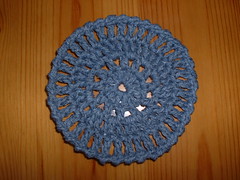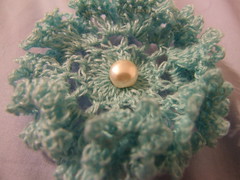I designed this little flower as an ornament for a Christmas parcel, at a friend's request. I liked it enough to submit it to SlipKnot, the journal of the Knitting and Crochet Guild.
You could also use it as an embellishment on a hat, bag, cushion etc, or attach a hair-slide or brooch pin to the back. It also works pretty well as a pen topper, but you may need a dab of glue to help it stay in place, depending on your gauge.
It's worked by crocheting twice into the same round - once into the front loops, then back round again into the back loops. You can create a bigger flower if you wish, by adding 4ch to the loops of each extra odd-numbered round, but the back of the flower does become quite thick, quite quickly.
DAISY, DAISY


MATERIALS
ABBREVIATIONS
beg - beginning
ch – chain
ss – slip stitch
sc - single crochet
dc – double crochet
FL - front loop
BL - back loop
Round 1: Ch 6, ss to close
Round 2: Ch1, dc into same space, 7 dc into ring, ss to 1st ch. (8dc)
Round 3: FL only - ss in first FL, ch6, ss in same loop, [ss into next FL, ch 6, ss into same loop] in remaining loops. (8 ch-6 loops)
Round 4: BL only, working into the back loops immediately behind front loops used in previous row - ch1, dc in each BL to end, ss into 1st ch. (8dc)
Round 5: FL only, working into the front loops of the dc created in previous row - ss in first FL, ch10, ss in same loop, [ss into next FL, ch 10, ss into same loop] in remaining loops. (8 ch-10 loops)
Round 6: Rpt row 4.
Round 7: FL only, working into the front loops of the dc created in previous row - ss in first FL, ch14, ss in same loop, [ss into next FL, ch 14, ss into same loop] in remaining loops. (8 ch-14 loops)
Fasten off and sew in ends. Ease petals into shape.
Round 1: Ch 6, ss to close
Round 2: Ch1, sc into same space, 7 sc into ring, ss to 1st ch. (8sc)
Round 3: FL only - ss in first FL, ch6, ss in same loop, [ss into next FL, ch 6, ss into same loop] in remaining loops. (8 ch-6 loops)
Round 4: BL only, working into the back loops immediately behind front loops used in previous row - ch1, sc in each BL to end, ss into 1st ch. (8sc)
Round 5: FL only, working into the front loops of the sc created in previous row - ss in first FL, ch10, ss in same loop, [ss into next FL, ch 10, ss into same loop] in remaining loops. (8 ch-10 loops)
Round 6: Rpt row 4.
Round 7: FL only, working into the front loops of the sc created in previous row - ss in first FL, ch14, ss in same loop, [ss into next FL, ch 14, ss into same loop] in remaining loops. (8 ch-14 loops)
Fasten off and sew in ends. Ease petals into shape.
Use any thread or yarn and an appropriately-sized hook to the yarn or thread you use. The size of the decoration will vary with the size of the fibre used.
For the example illustrated (about 2"/5cm diameter), I used a size 10 crochet thread held together with a strand of Twilley’s Goldfingering in Silver, worked with a 4mm (G) hook.
ABBREVIATIONS
beg - beginning
ch – chain
ss – slip stitch
sc - single crochet
dc – double crochet
FL - front loop
BL - back loop
INSTRUCTIONS - British terminology
Round 1: Ch 6, ss to close
Round 2: Ch1, dc into same space, 7 dc into ring, ss to 1st ch. (8dc)
Round 3: FL only - ss in first FL, ch6, ss in same loop, [ss into next FL, ch 6, ss into same loop] in remaining loops. (8 ch-6 loops)
Round 4: BL only, working into the back loops immediately behind front loops used in previous row - ch1, dc in each BL to end, ss into 1st ch. (8dc)
Round 5: FL only, working into the front loops of the dc created in previous row - ss in first FL, ch10, ss in same loop, [ss into next FL, ch 10, ss into same loop] in remaining loops. (8 ch-10 loops)
Round 6: Rpt row 4.
Round 7: FL only, working into the front loops of the dc created in previous row - ss in first FL, ch14, ss in same loop, [ss into next FL, ch 14, ss into same loop] in remaining loops. (8 ch-14 loops)
Fasten off and sew in ends. Ease petals into shape.
INSTRUCTIONS - American terminology
Round 1: Ch 6, ss to close
Round 2: Ch1, sc into same space, 7 sc into ring, ss to 1st ch. (8sc)
Round 3: FL only - ss in first FL, ch6, ss in same loop, [ss into next FL, ch 6, ss into same loop] in remaining loops. (8 ch-6 loops)
Round 4: BL only, working into the back loops immediately behind front loops used in previous row - ch1, sc in each BL to end, ss into 1st ch. (8sc)
Round 5: FL only, working into the front loops of the sc created in previous row - ss in first FL, ch10, ss in same loop, [ss into next FL, ch 10, ss into same loop] in remaining loops. (8 ch-10 loops)
Round 6: Rpt row 4.
Round 7: FL only, working into the front loops of the sc created in previous row - ss in first FL, ch14, ss in same loop, [ss into next FL, ch 14, ss into same loop] in remaining loops. (8 ch-14 loops)
Fasten off and sew in ends. Ease petals into shape.


